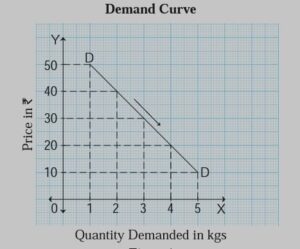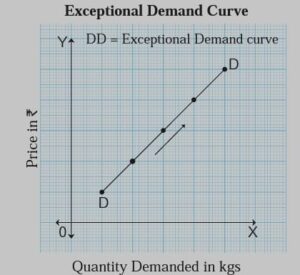Answer in detail
1) State and explain the ‘law of demand’ with its exceptions.
Ans:
Law of Demand:- Law of demand is one of the important basic laws of consumption. Dr Alfred Marshall, in his book “Principles of Economics”, has explained the law of demand as follows.
“Other things being constant the higher the price of the commodity, smaller is the quantity demanded arid lower the Mice of the commodity larger is the quantity demanded.”
The law of demand explains a change in the behaviour of consumer demand due to various changes in price. Marshall’s Law of demand describes the functional relation between demand and price. It can be expressed as D = f (P) that is demand is a function of price. The relation between price and demand is inverse because larger quantity is demanded when a price falls and smaller quantity will be demanded when the price rises. The law of demand is explained with the help of the following schedule and diagram.
Demand Schedule
Price of Mangoes Per Kg. (Rs.) | Demand for Mangoes (Kg.) |
50 | 1 |
40 | 2 |
30 | 3 |
20 | 4 |
10 | 5 |
As shown in the schedule when the price of mangoes is Rs. 5O/- per kg. demand is 1 kg. When the price falls to the level of Rs. 40/- per kg. and demand rises to 2 kg. Similarly, at the price Rs. 10/- per kg. the demand for mangoes is 5 kg., whereas 4 kg. of mangoes are demanded at price Rs. 20/- per kg. This shows an inverse relationship between price and demand.
In this diagram, X-axis represents demand for mangoes, whereas Y” axis represents the price of mangoes. DD is demand! a curve which slopes downwards from left to right. In other words, its slope is negative because of an inverse relationship between price and demand.
Exceptions to the Law of Demand:-
The Law of Demand explains an inverse relationship between the price of a commodity and the quantity demanded of it. Sometimes, however, we see a direct relationship between price and quantity demanded of a commodity.
Under exceptions to the Law of Demand, the demand curve slopes upwards from left to right which shows a direct relationship between price and quantity demanded. 
a) Giffen goods:-
Certain inferior goods are-ca1Md Giffen goods, when the price falls, quite often less quantity will be purchased than before because of the negative income effect and people’s increasing preference for a superior commodity with the rise in their real income. Sir Robert Giffen observed the situation related to demand for bread & meat in England. When the price of bread was decreasing, less bread was purchased. Here surplus money was transferred to purchase meat, as a result, demand for meat increased. This behaviour is known as Giffen’s paradox. Thus Giffen goods are inferior goods which have a direct relationship between price and quantity demanded, In this case, the demand curve slopes \ upwards from left to right as shown in the above diagram.
b) Prestige goods:-
Diamonds, high priced motor cars, luxurious bungalows are prestige goods. Such goods have a “snob appeal”. Rich people consume such goods as a status symbol. Therefore, when the price of such goods rises their demand also rises.
c) Price illusions or Consumers Psychological bias:-
Consumers have an illusion that high priced goods are of a better quality. Therefore the demand for such goods tends to increase with a rise in their price. e.g. Branded products which are expensive are demanded at a high price
d) Demonstration effect:-
The tendency of the low-income group to imitate the consumption pattern of high-income groups is known as Demonstration effect. For example demand for consumer durables such as washing machines, latest mobile etc.
e) Ignorance:-
Sometimes people do not have proper market knowledge. They may not be aware of the fall in the price of a commodity and thus they tend to purchase more at a higher price.
f) Speculation:-
When people speculate a change in the price of a commodity in the future, they may not act according to the Law of demand. People may tend to buy, more at rising price, when they anticipate further price rise. For example, in the stock market, people tend to buy more shares at rising prices. Even if prices of some goods like sugar, oil etc. are rising before Diwali, people go on purchasing more of these things at rising prices, because they think that prices of these goods may increase further during Diwali.
g) Habitual Goods:-
Due to a habit of consumption certain goods like tobacco, cigarettes etc are purchased even if prices are rising. Thus it is an exception.
2) Explain in detail the determinants of demand.
In ordinary language, demand means a desire. Desire means an urge to have something. In Economics, demand means a desire which is backed by a willingness and ability to pay.
Definition of Demand:
According to Benham, “the demand for anything at a given price is the amount of it, which will be bought per unit of time at that price.”
The demand for goods is determined by the following factors:
a) Price: Price determines the demand for a commodity to a large extent. Consumers prefer to purchase a product in large quantities when the price of a product is less and they purchase a product in small quantities when the price of a product is high.
b) Income: Income of a consumer decides purchasing power which in turn influences the demand for the product. The rise in income will lead to a rise in demand for the commodity and a fall in income will lead to a fall in demand for the commodity.
c) Prices of Substitute Goods: If a substitute good is available at a lower price then people will demand cheaper substitute good than costly good. For example, if the price of sugar rises then demand jaggery will rise.
d) Price of Complementary Goods: Change in the price of one commodity would also affect the demand for other commodities. For example, car and fuel. If the price of fuel rises, then demand for cars will fall.
e) Nature of product: If a commodity is a necessity and its use is unavoidable, then its demand will continue to be the same irrespective of the corresponding price. For example, medicine to control blood pressure.
f) Size of population: Larger the size of population, greater will be the demand for a commodity and smaller the size of population smaller will be the demand for a commodity.
g) Expectations about future prices: If the consumer expects the price to fall in future, he will buy less in the present at the prevailing price. Similarly, if he expects the price to rise in future, he will buy more in the present at the prevailing price.
h) Advertisement: Advertisement, sales promotion scheme, and effective sales-manship tend to change the preferences of the consumers and lead to demand for many products. For example, cosmetics, toothbrush, etc.
